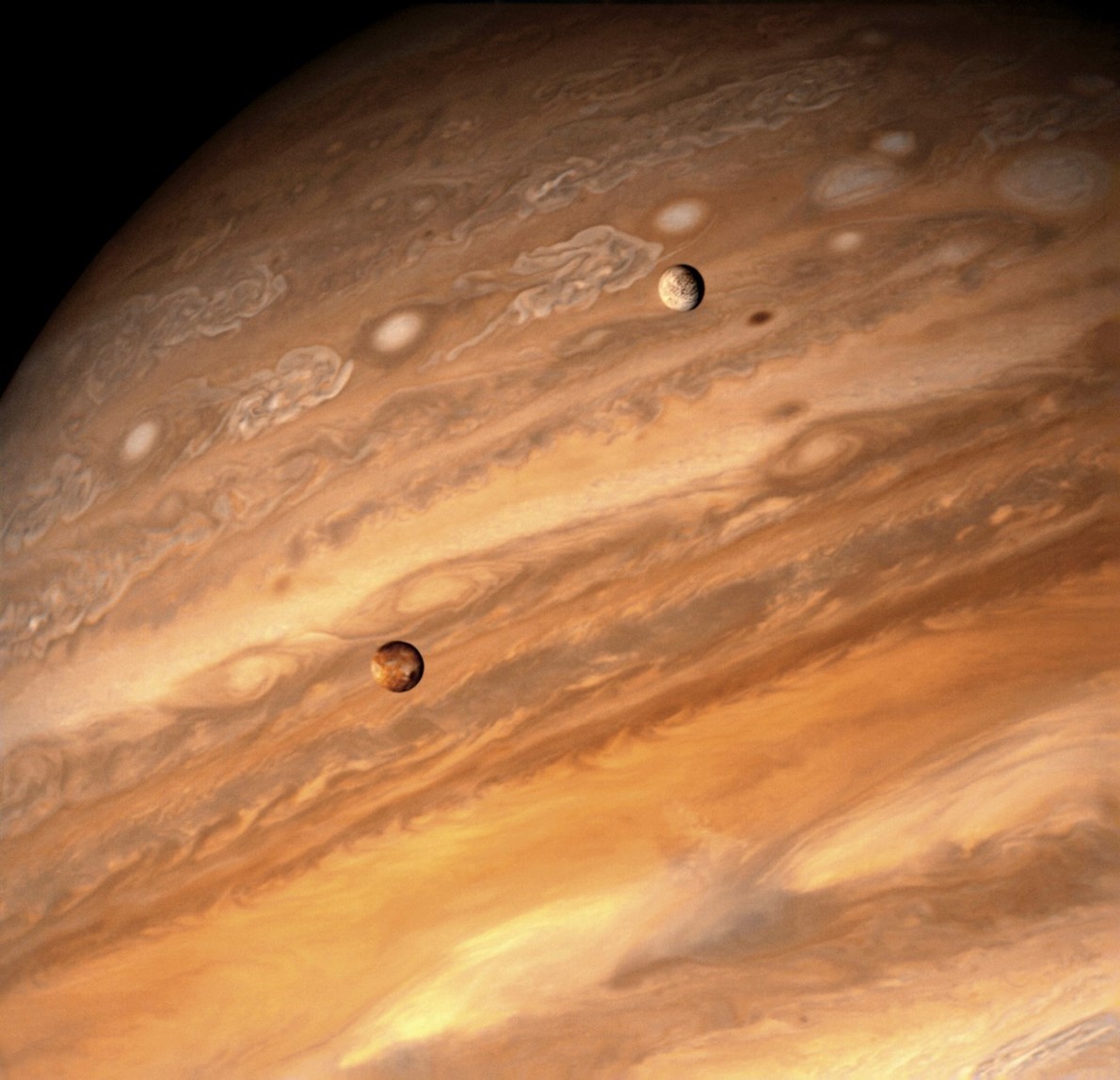A sightseeing alien touring our solar system would do well to check
out the emerald and blood orange-red ribbons of Earth’s auroras. But our world
is not the only one with spectacular light shows in its atmosphere. New
research shows auroras can also be seen on the Galilean moons of Jupiter:
hypervolcanic Io, icy Europa, quirky Callisto and gigantic Ganymede.
اضافة اعلان
Auroras exist throughout the cosmos, but often in wavelengths
that human eyes cannot see. Astronomers in two papers published this month in
The Planetary Science Journal are the first to report that if you were to stand
on the surface of Ganymede and Callisto, visible auroras would be dancing
above. The researchers also describe the existence of new types of visible
auroras on Io and Europa.
 An undated photo of
Jupiter’s moons Io, lower left, and ice-sheathed Europa, upper right, orbiting
across the face of the giant planet.
An undated photo of
Jupiter’s moons Io, lower left, and ice-sheathed Europa, upper right, orbiting
across the face of the giant planet.
The researchers captured the new auroras by peering through
telescopes in Hawaii, Arizona and New Mexico. The team spent years watching the
satellites repeatedly get swallowed by Jupiter’s shadow, then reemerge.
Catching elusive and ephemeral glows on distant, diminutive and
fast-moving moons can be difficult. But “the aurorae are always there when you
observe an eclipse,” said Katherine R. de Kleer, a planetary astronomer at the
California Institute of Technology and one of the authors of both studies. The
researchers tracked down the darkness-smothered moons frequently enough to
reveal the novel skyglows.
Galilean auroras are generated differently than those on Earth.
Magnetic fields and energetic particles ejected from the sun reach Earth and
are ensnared by our planet’s magnetic bubble. Those particles plunge toward the
north and south magnetic poles and crash into gas molecules in the upper
atmosphere, briefly energizing them and liberating various hues of visible
light.
As on Earth, the emergence of specific colors depends in part on an aurora’s altitude.
But other than Ganymede, the big moons of Jupiter lack magnetic
bubbles. Instead, their auroras owe their existence to Io. Its noxious
atmosphere — partly supplied by the moon’s epic volcanic eruptions — regularly
sheds into space. The castoffs mingle with sunlight and become electrically
excited. Plenty gets captured by Jupiter’s colossal magnetic bubble, but some
of it slams back into Io’s atmosphere, or into the other three moons’ gassy
sheaths. Those impacts are what ignite the moons’ auroral lights.
The researchers confirmed that all four moons’ skies glow in
green and red hues similar to those seen on Earth. Although less luminous than
our own world’s auroras, these otherworldly displays have their own beguiling
features.
The moons’ extremely thin atmospheres make their red auroras
shine far more intensely than their green ones do. Io, the oddest Galilean satellite,
has a streetlamplike yellow-orange radiance. This light show dims shortly after
Io enters Jupiter’s shadow. After reemerging, and bathing for a few hours in
sunlight, this sickly amber glow burns brightly again.
As on Earth, the emergence of specific colors depends in part on
an aurora’s altitude. But Io has an unusual mix of auroral pigments. “You would
get a rainbow effect,” said Carl Schmidt, a planetary astronomer at Boston
University and an author of both studies. Orange and red hues may be everywhere,
like different paint tinctures smeared together, but green would be found only
when an aurora occurs very high up.
These exotic fireworks are impressive. But the underlying
scientific goal of this work was to reveal the compositions and behaviors of
these moons’ atmospheres.
The colors in the moons’ auroras provide clues to the
ingredients in each world’s atmosphere. The dominant atmospheric component of
Callisto, Europa and Ganymede is molecular oxygen, which explains their newly
discovered green and red auroral tints. Io’s sickly orange comes from sodium
compounds, while a crimson light described for the first time in one of the new
papers comes from potassium.
These visible auroras also suggest that little water vapor
exists in the atmospheres of Europa and Ganymede, a finding that is surprising
considering that Europa and probably Ganymede contain vast liquid water oceans
beneath their frigid carapaces.
These visible auroras also suggest that little water vapor exists in the atmospheres of Europa and Ganymede, a finding that is surprising considering that Europa and probably Ganymede contain vast liquid water oceans beneath their frigid carapaces.
The Jupiter Icy Moons Explorer, a European Space Agency
spacecraft that may launch in April, could help resolve this enigma. “Perhaps
with a closer look, we can definitively figure out how much, if any, water is
in the atmosphere of Europa,” said James O’Donoghue, a planetary astronomer at
the Japan Aerospace Exploration Agency who is not involved with the studies.
Confounding chemistries aside, any astronaut photographing these
Galilean glows — backgrounded by tempestuous Jupiter and the gas giant’s own
kaleidoscopic auroras — would capture a memorable sight. Above all else, these
studies demonstrate that beauty is not unique to Earth. If we are willing to
search for it, enchanting scenes can be found anywhere in the cosmos.
Read more Lifestyle
Jordan News



